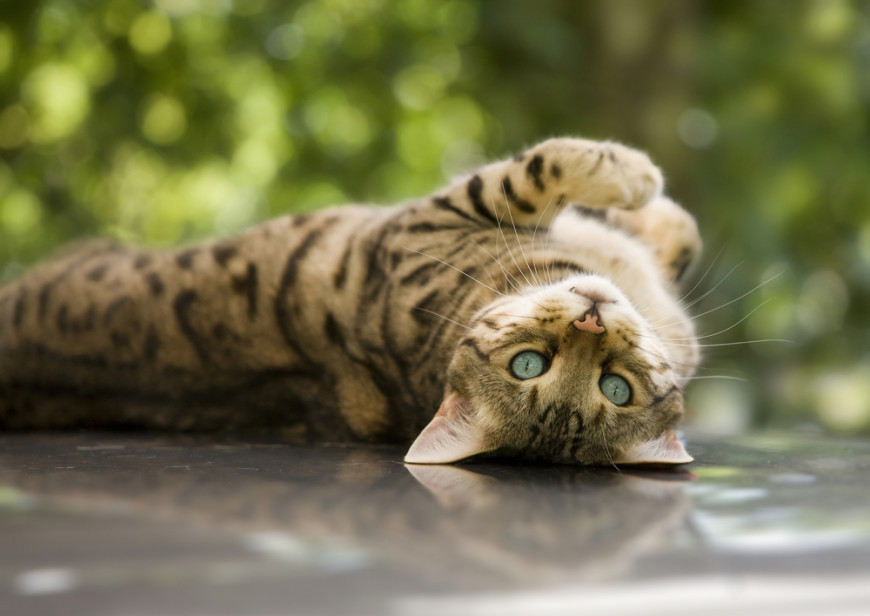
Is my cat safe outdoors?
These are dangerous times for outdoor cats. The number of vehicles on the nation’s roads now outnumbers the number of cats by almost five to one. And given at least 75% of cats spend some of their life outside, it’s perhaps little surprise that an estimated 630 are run over on Britain’s roads every day.
Many of the emergencies we see are caused by road traffic accidents. These rise proportionately in autumn. Typically, younger cats are the victims, which is probably because they haven’t yet become street-wise. According to one study, the likelihood of a cat being involved in a road traffic accident goes down by 16% for every year increase in the cat’s age.
The same study showed that almost half of cats killed or seriously injured by a car are between the ages of seven months and two years old. If they manage to avoid a road traffic accident, most cats will go on to live into old age.
Don’t delay if you’re worried your cat has been involved in an accident – call your vet or, out of hours, your nearest Vets Now pet emergency clinic or Vets Now 24/7 hospital.
Should I keep my cat indoors?
This is a huge bone of contention. In some countries, it’s illegal to allow your cat outdoors at all without a lead. The proportion of owners who give their pets a licence to roam is far lower in mainland Europe, the US and Australia than it is in the UK. But in Britain domestic cats have been able to wander freely for hundreds of years.
Indeed, it is only since the 1950s – and innovations such as commercial cat food, cat litter and an increase in neutering – that some owners have shown a predilection for keeping their cat inside 24-hours-a-day, seven-days-a-week.
Some experts say cats need outdoor time to get sufficient exercise, satisfy their predatory instincts and to have their senses stimulated. Others claim indoor cats can still get that if their home is set up in the right way. The statistics show indoor cats typically enjoy longer, physically healthier lives than those allowed outdoors.
But indoor cats are also more likely to develop behavioural and psychological problems than their outdoor counterparts and develop some physical illnesses associated with a sedentary lifestyle.
What increases the risk of my cat being involved in a road accident?
Studies have shown there are four main factors which increase the likelihood of a cat being involved in a road traffic accident. These are:
- Living in areas where traffic levels are high
- Being unneutered – entire males tend to roam further from their home than females
- Age – younger cats are more at risk due to their lack of street awareness
- Time – most accidents involving cats occur at night and close to the cat’s home
Does the street I live in make a difference?
One study revealed cats who live in houses on “long, straight sections of road” are more likely to be struck by a car. The research, by academics at the University of Bristol, looked into risk factors for road traffic accidents in cats aged up to a year. It found that almost 54% of RTAs take place in the dark while 75% result in fatal injuries. Around two-thirds of cats involved in RTAs live in a house on a long, straight road. The authors recommended that staff from cat rehoming organisations take their findings into account when assessing the suitability potential cat owners.
What can I do to make my cat safer?
There are pros and cons to allowing your cat outdoors but if you choose to let them out there are lots of ways to help ensure they come home safe and well. These include:
- Neutering – unneutered male cats are more likely to roam across busy roads and they’re more likely to get into fights
- Keeping them indoors at night – this is a good compromise because cats are more likely to get into accidents during the hours of darkness
- Giving them time to get used to their surroundings – if you’ve just moved home or have a young cat give her time to make a “mental map” of her surroundings before allowing her greater freedom
- Using a ‘quick release’ reflective collar – these are widely available online and in pet stores
- Keeping your cat within eyesight – there is fencing designed to help cat owners keep their pets in their garden and collars with GPS to allow you to locate them anytime
- Microchipping – as long as you keep your details up-to-date, this will help ensure your cat is returned if she does go missing or get injured. Remember, microchipping doesn’t mean your pet has GPS, the unique number in the chip is stored in a database along with your contact details

